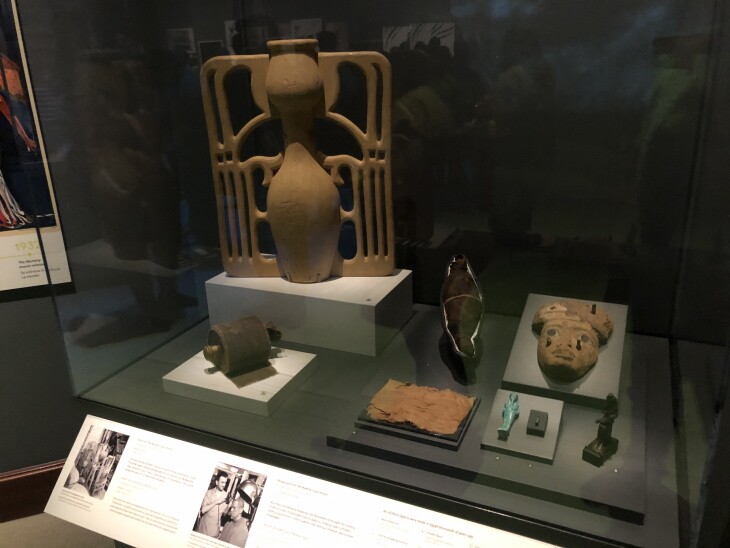Truth matters. Community matters. Your support makes both possible. LAist is one of the few places where news remains independent and free from political and corporate influence. Stand up for truth and for LAist. Make your year-end tax-deductible gift now.
Frankenstein, Dracula And The Mummy Are Haunting LA's Natural History Museum

Dracula, Frankenstein, and the Mummy are among the most iconic movie monsters -- and they all have real-life inspirations. The Natural History of Horror exhibition at L.A. County's Natural History Museum explores the science and the history behind Universal's classic creatures.
The museum was one of the few movie prop collectors out there when it began its collection in 1930. Many of its pieces were donated by Universal Studios in 1935, and both the studio and the family of its founder have donated objects over the years.
"Because we began so early, and before it was considered a real industry worthy of collecting, we were the first out of the door," museum collections manager Beth Werling told journalists at a press event. "So all of the major studios, and many of their founders, the inventors, the animators, etcetera, donated to us."
Here's what you'll discover and what you can see in this exhibition:
CREATURE FROM THE BLACK LAGOON (1954)

The Creature's costume was designed by Milicent Patrick, who was inspired by both living and long extinct animals. She combined reptiles, amphibians, fish, and ancient animals to create the memorable aquatic aesthetic.

They have on display silicone copies of both the full Creature body suit, as well as the mask that makes up its head. Those are right alongside a fossilized coelacanth, which has limb-like fins that was once believed to be the missing link between sea life and land animals.
DRACULA (1931)

Vampires had been legendary before 1897's Dracula by Bram Stoker, but 19th century diseases are thought to have helped inspire the modern version of vampires popularized through book and film. That includes cholera victims, who were buried during 1830s epidemics within hours of their death -- and sometimes even before they died, in order to keep the disease from spreading.

That led to fears about being buried alive, along with the dead coming back from the grave. Those fears play into the 1931 film, adapted from the novel. Artwork and illustrations from the 1830s are showed alongside film stills and props, including a vampire bat used in the film.
It's not all death and scares -- the exhibition also includes a display on foley, illustrating how the sound effects of early horror films like Dracula were created. They've got everything from a device to make the sound of bats flapping to the classic coconut halves to simulate a galloping horse.
Jeff Pirtle, NBCUniversal archives and collections director, credited German immigrants bringing German expressionism to the States with the rise of monster movies in the early days of film, combined with the beginning of movie sound.
FRANKENSTEIN (1931)


Part of the inspiration behind Frankenstein comes from 19th-century scientist Luigi Galvani's early experiments with animals and electricity, which you can re-create yourself at the museum. Pull a lever and send electricity through a frog's leg, and you'll see the limb reanimate right in front of you.
The museum has a prop on hand you don't see in the final film: shackles that restrained the Monster as he was taunted and tormented by Dr. Frankenstein's assistant. The classic film was thought by censors to be too graphic at the time, with this scene left on the cutting room floor, along with other scenes that were cut or shortened.
THE MUMMY (1932)


The Mummy entered the popular consciousness due to the early 20th century excavation of the tomb of Tutankhamun. In 1922, King Tut's intact burial chamber was unearthed after 3,000 years.
Due to a mistranslation of an inscription outside the tomb, combined with the deaths of some of those involved with the excavation, popularized the notion of the mummy's curse.
The props on display here include mummy wrappings used in the 1932 movie, worn by legendary horror actor Boris Karloff. Turning him into a monster took eight hours of makeup, including fuller's earth (a clay mixture), cotton soaked in the chemical collodion, and 150 feet of those bandages.
AND MORE
It's not a huge exhibition, but there's more to explore. Another movie monster will be joining his friends next week -- or enemies, depending on how you look at it. Godzilla: A Living Atomic Bomb opens Wednesday, Oct. 16 and focuses on the real-life nuclear tests on Bikini Atoll that inspired the creature.

Beyond the horror exhibition, more of the museum's Moving Image collection can be seen in the gallery next door as part of the vast Becoming Los Angeles exhibition.
The Natural History of Horror started as an idea from museum collections manager Werling, who pitched an idea several years ago called Children of the Night. That evolved into this exhibition.
Special screenings of the movies featured in this exhibition are planned throughout its run. The events will include special performances, access to the exhibition, and snacks. Some bonus items will also be shown off, including a pitchfork and a broom from the Bride of Frankenstein whose origins were only recently identified.
"I was able to go over to the [Universal] archives and verify it with stills in their key books," Werling said.
The programs include:
- Friday, Oct. 11: Bite Into This with Dracula
- Friday, Feb. 14: Unrequited Love with the Creature from the Black Lagoon
- Thursday, March 26: Monster Fears with Frankenstein
- Friday, April 10: All Wrapped Up with the Mummy
The exhibition may seem perfect for the Halloween season, but if you don't have time before All Hallows' Eve, no need to fear -- it's open now and runs through April 19, 2020.
And Universal isn't out of the monster business yet. Their remake of The Invisible Man hits theaters in March.







